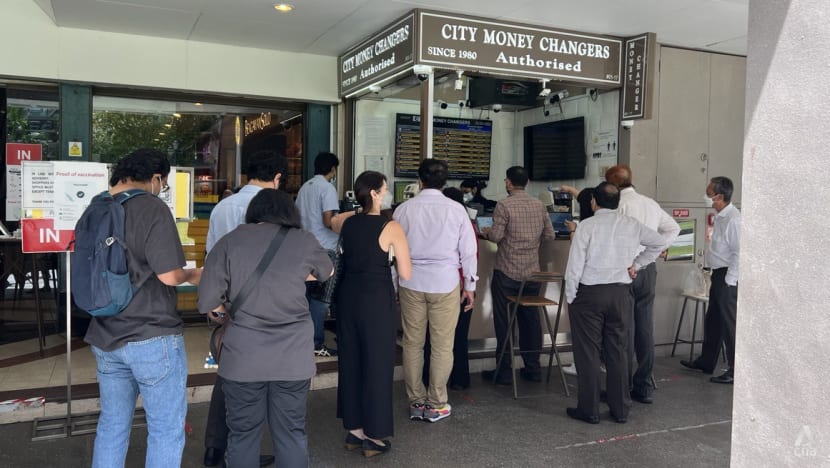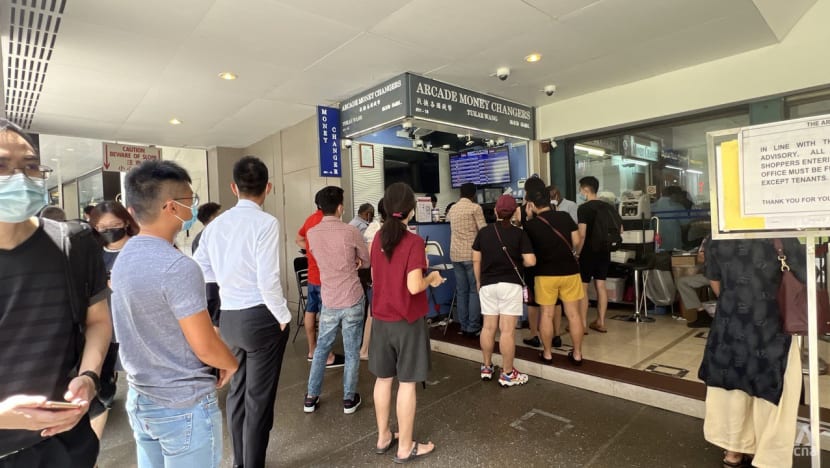Queues form at money changers, ringgit out of stock as it weakens further against Singapore dollar

Money changers at The Arcade in Raffles Place that still had Malaysian ringgit in stock on Apr 25, 2022 saw queues form at lunchtime. (Photo: CNA/Ang Hwee Min)
SINGAPORE: Money changers in central Singapore saw a surge of people lining up to buy Malaysian ringgit on Monday (Apr 25), as it weakened further against the Singapore dollar.
The Singapore dollar was at 3.17 against the Malaysian ringgit at about 6pm on Monday, up from 3.10 levels in early April.
This is already more than 2 per cent up over the past one to two weeks, said senior currency analyst at MUFG Bank Jeff Ng.
From 1pm to 2.30pm, long queues formed outside money changers at The Arcade at Raffles Place without abating. Many people were there to change Singapore dollars into Malaysian ringgit, employees told CNA.
Money changers at The Arcade and People’s Park Complex were selling Malaysian ringgit at a rate of S$1 to RM3.10 to RM3.12.
At The Arcade, at least seven money changers were out of Malaysian ringgit by about 2.30pm and had to turn some customers away.
“That’s why here no queues,” said an employee at Money Matters Foreign Exchange on the second floor of The Arcade, who declined to be named.
Money changers at The Arcade and People’s Park Complex said they started to see more customers looking to change Singapore dollars for Malaysian ringgit from last week, with even more looking to exchange currencies on Monday.
Most of the outlets that had the currency in stock saw queues during lunchtime, with customers changing up to S$3,000 to S$4,000 for Malaysian ringgit.
“I’ve got no more stock. Just finished today,” said an employee at Hasan Trading Money Exchange, who only wanted to be known as Mr Ismail.
“The holidays are coming, that’s why people buy ringgit. Hari Raya also is very important,” he said, noting that the Singapore-Malaysia land borders have also reopened.
Following the reopening of the Singapore and Malaysia land borders for fully vaccinated travellers earlier in April, the Government said last week that cross-border bus services will resume from May 1.
Cross-border taxi operations will also resume from May 1, about two years after these services were suspended due to the COVID-19 pandemic.
Mr Nasu of Sirajudin Money Changer at People’s Park Complex said the outlet saw long queues over the weekend. The outlet still had Malaysian ringgit in stock and was quieter compared to those at Raffles Place.
“The weekend on Saturday, Sunday there was a lot of people. They opened the border so people can come in. They relaxed measures so more people want to go,” he added.
An employee at Samlit Moneychanger in the same mall said they have not had Malaysian ringgit in stock since the border reopened.
CENTRAL BANK DIVERGENCE
Experts CNA spoke to pointed to differing monetary policies pursued by the Monetary Authority of Singapore (MAS) and Bank Negara Malaysia (BNM) to explain why the Singapore dollar has been rising against the Malaysian ringgit.
Singapore has pursued a more aggressive monetary policy by appreciating the Singapore dollar at a faster pace and at a higher level, noted Mr Ng.
BNM has been “more cautious in its consideration to normalise monetary policy” and has maintained a “relatively neutral stance” since March, he added, citing “some central bank divergence”.
This is due to high inflation in Singapore, whereas Malaysia’s inflation has been more stable, with Government price controls for certain items, said Mr Ng.
MAS tightened its monetary policy for the third time in six months, its most aggressive move out of the three.

While policy tightening was widely expected this time amid rising inflation, the two-in-one move was a surprise for some observers.
The authorities first tightened its policy in October last year when it raised the slope of its exchange-rate based policy band to allow the Singapore dollar to appreciate at a slightly faster pace. It then followed up with another steepening of the slope in January, surprising markets with an inter-meeting adjustment.
As it released its half-yearly policy statement earlier in April, the Singapore central bank said it would raise the slope of appreciation “slightly” yet again, while re-centering the mid-point of the policy band “at the prevailing level”.
Doing so will help to “slow the inflation momentum and help ensure medium-term price stability”, it noted.
Currency Strategist Sim Moh Siong at the Bank of Singapore noted that the rising inflation is not a Singapore problem, but a global problem.
“Eventually, I think there is the expectation here that Bank Negara will have to raise rates to fight inflation. Right now it’s not that obvious, but I think some of these rising commodity prices will seep through into the (Consumer Price Index) basket, and that could lead to rising inflation,” he added.
He foresees that Malaysia’s central bank will raise interest rates later this year, which “should support the ringgit”.
However, Singapore’s central bank may also further tighten its monetary policy in October, noted Mr Sim.
Last week, the Malaysian ringgit to Singapore dollar rate closed at 0.3158, close to the record low of 0.3151 in 2017, noted DBS senior FX strategist Philip Wee.
Last week’s 1.5 per cent depreciation was also the worst weekly decline since Nov 2016, he added.
“MYR has been depreciating against SGD since 2018, reflecting Singapore’s relatively stronger fundamentals over its neighbour. It was just that the gradient of the descending price channel has been modest and steepened only in recent months,” said Mr Wee.
MUFG Bank expects this trend to persist over a 12-month period, and recently revised up its forecast for the US dollar against the Singapore dollar from 1.30 to 1.32 at the end of the first quarter next year, said Mr Ng.
The bank also foresees “some risks” that the ringgit will fall short of its current forecast of 4.14 at the end of the first quarter of next year.
According to these estimates, the upside for the Singapore dollar and Malaysian ringgit exchange rate is expected to continue, forecasted at 3.13, 3.17, 3.18 and 3.18 for the next four end-quarters, he added.
“We expect upsides to stabilise once inflation moves higher and turns more into a concern for Malaysia and BNM turns more hawkish. However, upside trends are still likely from MAS’ appreciationary exchange rate policy stance.”
Mr Wee estimates that once the support at 3.150, or the low for 2017, breaks, the lowest it will go is about 3.050 for the rest of 2022.
“Tourism is only one factor affecting the MYR/SGD cross rate. The larger concerns weighing on Asian currencies especially the externally-led ones are the dampened global outlook after Russia invaded in Ukraine, the depreciation in the Asian currencies especially the major ones like (the Chinese yuan and Japanese yen) and monetary policy divergences.”



















